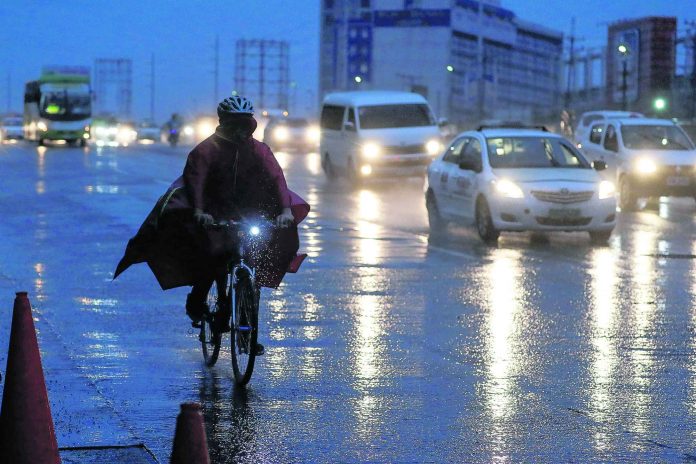A typhoon began battering northeastern Philippine provinces Wednesday, leaving at least one person dead and three missing in a region still struggling to recover from a powerful storm that left a trail of death and destruction just over a week ago, officials said.
Typhoon Vamco strengthened with sustained winds of 140 kilometers (87 miles) per hour and gusts of up to 195 kph (121 mph) as it barreled close to the Polillo islands in Quezon province Wednesday night. Nearly 200,000 people have been evacuated to safety in the region, some of them forcibly, officials said.
Quezon and outlying provinces have hardly recovered from the devastation wrought early this month by Typhoon Goni, which blew ashore with destructive super-typhoon force but weakened after slamming into mountain ranges and a string of island provinces. One of the strongest typhoons in the world this year, Goni left more than 30 people dead or missing and damaged or destroyed more than 270,000 houses and shanties, many along coastal villages.
“This typhoon will test once more our spirit, bruised but not broken,” military chief of staff Gen. Gilbert Gapay said of the new typhoon.
Navy, air force and army forces have remained on high alert from the last typhoon and again deployed disaster-response contingents in high-risk areas ahead of the onslaught, Gapay said in a statement.
Disaster-response officials reported flooding in 32 towns near the country’s northeastern coast and a few landslides in the agricultural region, where they said a man died and three others were missing, without immediately providing details.
More than 187,000 villagers fled to safety Wednesday, about half of them taking shelter mostly in government-run evacuation centers, according to the Office of Civil Defense.
Tens of thousands of others remained displaced after losing their homes in Goni’s devastation, including in the hard-hit island province of Catanduanes, where that typhoon made landfall on Nov. 1 and damaged or destroyed tens of thousands of coastal shanties, houses and buildings, including emergency shelters, and knocked down power and communications.
In Guinobatan town in nearby Albay province, heavy rain generated by Goni washed down volcanic mud, debris and boulders in a torrent of mudflow that engulfed about 150 houses. The owners of those houses remain displaced and were warned against returning to the mudflow-inundated community as the new typhoon approached.
The government’s main disaster-response agency pleaded to the media to help authorities relay typhoon alerts in the Goni-devastated northeastern region, saying it could not send messages by cellphones due to damaged telecommunications systems.
With its wide band of rain clouds, Typhoon Vamco may pass about 50 kilometers (31 miles) north of the capital, Manila, at dawn Thursday if it doesn’t shift course, forecasters said.
Classes and government work were suspended in the capital and outlying regions Wednesday. Several international and domestic flights were canceled. Seaports were closed and ferry boats and cargo ships were prohibited from venturing out to sea near the typhoon’s path, stranding hundreds of commuters, officials said.
Authorities warned of storm surges of up to 2 meters (6 feet) in Manila and outlying coastal cities, and villagers along the coast and low-lying areas were advised to move to safer ground.
The Philippines is hit by about 20 typhoons and storms each year. It’s also located on the so-called Pacific “Ring of Fire,” where earthquakes and volcanic eruptions are common, making it one of the world’s most disaster-prone countries.



















